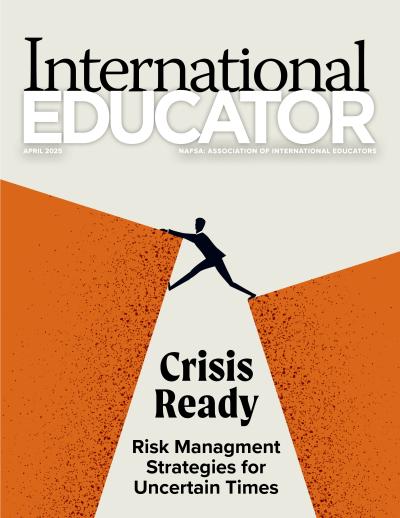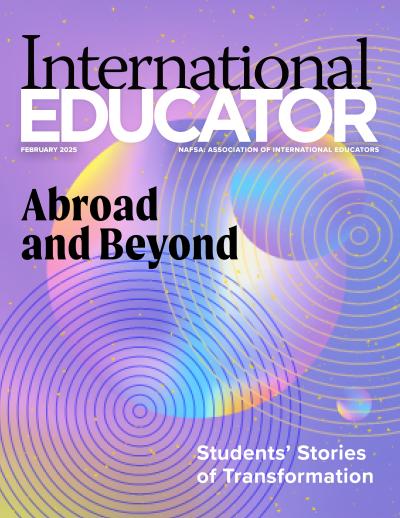At Your Service: Connecting International Students to Volunteer Opportunities

When international students arrive to study in the United States, they are invariably focused on making the most of their education. By design and by necessity, the college becomes their world.
“The college bubble can be so great and so rich that stepping outside of it doesn’t feel necessary,” says Emma Swift, PhD, associate director of the Office of International Education at the University of Vermont.
But as many institutions know, the college bubble presents international students with only a partial picture of the United States and their community. To fully understand U.S. culture and deepen the knowledge they gain on campus, they need broader experiences—and that’s where volunteer opportunities come in.
“Volunteer opportunities help students, particularly international students, get out of the campus bubble,” says Eva Wong, PhD, director of the Office of International Students, Scholars, and Programs at the College of William & Mary. “It’s a great way to connect what they are learning in classrooms with things that are happening with off-campus communities.”
Creating a Full Experience for International Students
Wong notes that volunteering pays multiple benefits to students, socially, culturally, and professionally. “Experience has shown that when a student is more engaged in the campus [and the] local community, it creates a sense of belonging and helps the student flourish during their time at the university,” she says.
Building social connections is a big part of students’ experiences, and volunteering presents opportunities for them to meet and engage with their peers. “It’s a great way for students to connect with other students who have the same passion for a certain set of work or a certain issue,” Wong adds.
“It’s a great way to connect what they are learning in classrooms with things that are happening with off-campus communities.” —Eva Wong
Volunteering also offers students a glimpse at a fuller picture of U.S. society. Swift recalls a conversation with a student working at a thrift shop at a women’s shelter. “He was hanging up used clothes, and he had never imagined that Americans would wear second-hand clothes,” she says. “That student’s concept of America was driven by the concept that the United States was a place of abundance.”
Long-term volunteer experiences can have effects on a students’ career interests and paths as well. “Volunteering can often be a first step for our students to get exposed to more groups, more diverse ways of communicating, [and] things that they might see in [other] work settings,” says Jane Sitter, MA, an international career consultant in the University of Minnesota Office for Student Affairs. “I have heard from international alumni that oftentimes their first position outside of campus was a volunteer role that supported obtaining jobs in future.”
Benefits to the Broader Community
Another benefit: Engaging international students in volunteer opportunities contributes to campuswide internationalization efforts.
“It is important for people at the university or alums to see the students not only come here to get a fantastic education, but are giving back to the community,” says Adria Baker, EdD, associate vice provost for international education at Rice University.
Indeed, Tia Gomez Zeller, MS, associate director for international retention at Lane Community College, made a point, prepandemic, of ensuring that international students were front and center for any volunteer opportunities on campus.
“The school literally saw how important international students are,” Gomez Zeller says. “[Other departments] were investing in our program because everywhere they could see international students were helping.”
For a variety of reasons, Gomez Zeller recommends starting any volunteer program with a focus on campus. “Volunteering on campus gets people excited,” she says. “Then they will talk to their friends and get them excited,” creating momentum to build upon.
Connecting Students with Volunteer Opportunities
Structuring volunteer opportunities for international students begins with an institutional commitment to volunteerism in general. “At our institution, service is one of our core values,” says Wong.
Many campuses also have a central office dedicated to matching students with volunteer opportunities. International offices can connect with these volunteer hubs to ensure international students are aware of the opportunities available to them. Sometimes that requires a little extra support from the international office.
“If our Office of Community Engagement is organizing a trip to a local nonprofit, we recommend a group of international students and offer them transportation,” says Wong, noting that transportation is often a limiting issue for international students.
“Think broadly about what volunteering or community engagement looks like. There are so many other campus partners who are doing similar work.” —Eva Wong
Wong also points out that there are many opportunities for students beyond those organized by the main volunteerism office. “Think broadly about what volunteering or community engagement looks like,” she advises. “There are so many other campus partners who are doing similar work.” For example, she points to the Office of Sustainability taking students to a local farm. “We don’t need to reinvent the wheel,” says Wong. “See what’s happening on campus and locally.”
Though most volunteer opportunities will be vetted through a central office, if the campus has one, some off-campus opportunities are easier to take advantage of than others. “You want ones that don’t require background checks or [excessive] training,” says Swift.
Engaging in Outreach
Certain types of activities are more appealing to international students than others. “Partnerships with local schools tends to be popular,” says Wong. “Being able to work with other students, younger students, is appealing.” She adds that Habitat for Humanity is also a popular volunteer choice for international students.
Many international students remain on campus through winter and spring breaks, and “isolation is a big issue for many students,” says Wong. “Their peers are gone for breaks, and they are stuck on campus.” Volunteer opportunities during breaks are a chance to relieve some of the isolation that they might be feeling.
“Volunteering is not something I have to sell. Many of our students came with the idea that they want to give back to the country that is helping them to grow.” —Tia Gomez Zeller
Undergraduate students tend to be more likely to participate in volunteer opportunities, but given the right program, graduate students will step up as well. Rice has had success with a program called the GREAT (Global Rice Empowers Academics and Training) Project, in which graduate students teach young adults with intellectual and developmental disabilities math, science, and language skills. After a pause for the pandemic, the program is resuming this month with an arts walk on campus.
The key to engaging students is personal outreach, says Swift. “Marketing is better when you’re in conversations versus sending out an email,” she says. Swift is now bringing in a new staff member to set up a volunteer series for international students at the University of Vermont. “I anticipate when we launch it will be really small, and we will have to be the hype squad for it,” she says.
The good news is that international students are a receptive audience. “Volunteering is not something I have to sell,” says Gomez Zeller. “Many of our students came with the idea that they want to give back to the country that is helping them to grow.” •
NAFSA Resources
About International Educator
International Educator is NAFSA’s flagship publication and has been published continually since 1990. As a record of the association and the field of international education, IE includes articles on a variety of topics, trends, and issues facing NAFSA members and their work.
From in-depth features to interviews with thought leaders and columns tailored to NAFSA’s knowledge communities, IE provides must-read context and analysis to those working around the globe to advance international education and exchange.
About NAFSA
NAFSA: Association of International Educators is the world's largest nonprofit association dedicated to international education and exchange. NAFSA serves the needs of more than 10,000 members and international educators worldwide at more than 3,500 institutions, in over 150 countries.
NAFSA membership provides you with unmatched access to best-in-class programs, critical updates, and resources to professionalize your practice. Members gain unrivaled opportunities to partner with experienced international education leaders.














